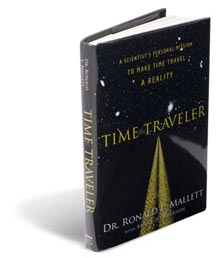  |
| HOME | THIS ISSUE | CALENDAR | GRANTS | BACK ISSUES | < BACK | NEXT > |
Physicist’s new book recounts personal quest for time travelby Kenneth Best - November 6, 2006 |
||||
| Great storytellers receive applause from their audience following their tale. In his new book Time Traveler: A Scientist's Personal Mission to Make Time Travel a Reality (Thunder's Mouth Press), UConn physics professor Ronald Mallett recalls the time his students applauded after a lecture.
Publisher's Weekly says Mallett's "simple prose makes for clear and concise explanations of the science involved," noting that "he must be an excellent teacher." Mallett says he could not separate his drive to pursue time travel from his life; his passion for his work stems from the premature death of his father, who died at age 33 from a heart attack. After reading The Time Machine by H.G. Wells, Mallett hoped to see his father again by going back in time. "I want people to realize this interplay of science in my life is woven into the fabric of my life," he says. "I didn't want it to be a science lesson. By having it autobiographical, I want readers to acquire the science information as I did." The physicist says he kept his work on time travel a closely held secret for years, fearing ridicule. However, a colleague at the University of Michigan, astrophysicist Fred Adams, encouraged him to "come out of the time travel closet," because many other respected physicists were beginning to do serious research into the subject. "Fred had originally suggested doing a book about it," Mallett recalls. "I didn't want to write a book about other people's contributions to time travel, unless I made a contribution." The favorable reaction and publicity surrounding the publication of his time machine concept in the journal New Scientist in 2001 established Mallett as a pioneering contributor to the theory of time travel. He continued working and publishing papers on the theoretical equations needed to complete the concept, culminating in the publication of the second part of his theory in the journal Foundations of Physics in 2003. He says the basic equations are founded upon "solid physics," including Einstein's general theory of relativity, which indicates that the key to time travel - creation of a gravitating field of circulating light that will simultaneously twist space and time - is possible according to the laws of nature. Mallett hopes Time Traveler will help draw support for moving his theoretical work to the experimental phase of building a time machine. While there has been interest from some government agencies and Wall Street investors, he refuses to do his work in secret, as those potential funding sources required. "Any new technology needs to be regulated, but that's different than being top secret," he says. "Regulation does not mean complete, exclusive control. It would be the equivalent of the government realizing that flight was possible with the Wright Brothers and calling it top secret. I have faith there will be visionaries out there who have the money and vision to say this is something that needs to happen." He continues to collaborate with Chandra Roychoudhuri, a research professor of physics at UConn, who will carry out the experiments necessary before moving to phase two - actual construction of a time machine. As part of his national book tour, Mallett will sign copies of Time Traveler at the UConn Co-op on Friday, Dec. 8.
|
| ADVANCE HOME UCONN HOME |

 Mallett's autobiographical story of his quest to build a working time machine - which includes a crash course in physics - is generating a similarly enthusiastic response.
Mallett's autobiographical story of his quest to build a working time machine - which includes a crash course in physics - is generating a similarly enthusiastic response.